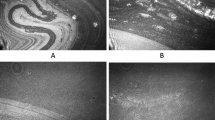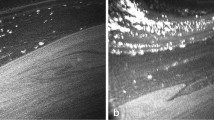Abstract
The biophysical behaviour of the Meibomian gland secretion was tested underin vitro conditions. Thereby, simultaneous recording of surface pressure and surface potential was performed. The Meibomian lipid layer was compared with other surface-active components like polyvinylalcohol and polyvinylpyrrolidone. On the other hand, Eledoisin was tested as an example for a surface-inactive substance. An attempt was made to describe the biophysical interaction between a given artificial tear substitute and the Meibomian lipid layer. With respect to the surface potential Dipalmitoyl-phosphatidyl-choline was established as an analogue for Meibomian gland secretion. Fluorescence measurements in the presence of a cyanine dye (1 N,N′ dioctadecyloxacarbocyanine) were used as a method to localize the site of the characteristic potential change. From the fluorescence spectra under compression we conclude that the molecular change takes place at the lipid-subphase interface of the Meibomian lipid layer.
Similar content being viewed by others
Abbreviations
- DPPC:
-
dipalmitoyl-phosphatidyl-choline
- MGS:
-
Meibomian gland secretion
- PVA:
-
polyvinyl-alcohol
- PVP:
-
polyvinyl-pyrrolidone
References
Holly F, Lemp M. Wettability and wetting of corneal epithelium. Exp Eye Res 1971; 11: 239–50.
Holly F. Surface chemistry of tear film component analogues. J Colloid Interface Sci 1974; 49: 221–31.
Jaeger W, Möbius D, Kaercher T. Biophysical experiments with lipid-layers formed with Meibomian gland secretion. In: Holly F (ed) The preocular tear film in health, disease and contact lens wear. Lubbock, 1986: 609–21.
Sondermann J. Darstellung oberflÄchenaktiver Polymeth-incyanin-Farbstoffe mit langen N-Alkyl-Ketten. Liebigs Ann Chem 1971; 749: 183–97.
Kuhn H, Möbius D, Bücher H. Spectroscopy of monolayer assemblies. In: Weissberger A, Rossiter B (eds) Physical methods of chemistry. Wiley and Sons, 1972: 577–702.
Bertaccini G, de Caro G. The effect of Physalaemin and related polypeptides on salivary secretion. J Physiol 1965; 181: 68–81.
Vogel V, Möbius D. Local surface potentials and electric dipole moments of lipid monolayers: Contributions of the water-lipid and the lipid-air interfaces. J Colloid Interface Sci 1988; 126: 408–20.
Holly F. Surface chemical evaluation of artificial tears and their ingredients. Interaction with a superficial lipid layer. Contact and Intraocular Lens Med J 1978; 4: 52–65.
Kaercher T, Möbius D. StabilitÄt und FlexibilitÄt der Lipidschicht des TrÄnenfilms sowie deren pathologische VerÄnderungen im biophysikalischen Experiment. Fortschr Ophthalmol 1989; 86: 245–8.
Möbius D, Cordroch W, Loschek R, Chi L, Dhathathreyan A, Vogel V. Control of interfacial equilibria by local charge distribution and average surface potential. Thin Solid Films 1989; 178: 53–60.
Author information
Authors and Affiliations
Rights and permissions
About this article
Cite this article
Kaercher, T., Möbius, D. & Welt, R. Biophysical characteristics of the Meibomian lipid layer underin vitro conditions. Int Ophthalmol 16, 167–176 (1992). https://doi.org/10.1007/BF00916437
Issue Date:
DOI: https://doi.org/10.1007/BF00916437




